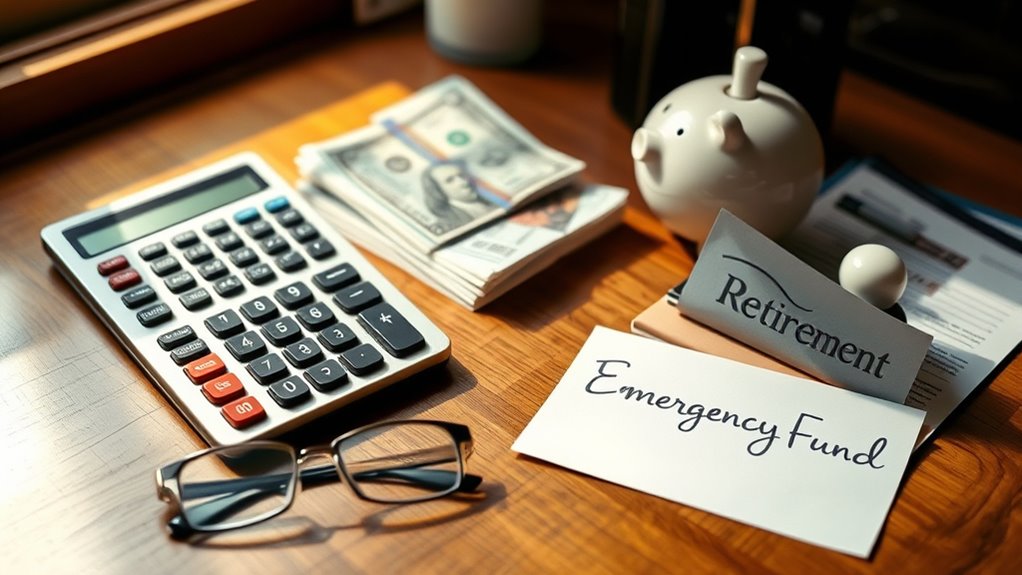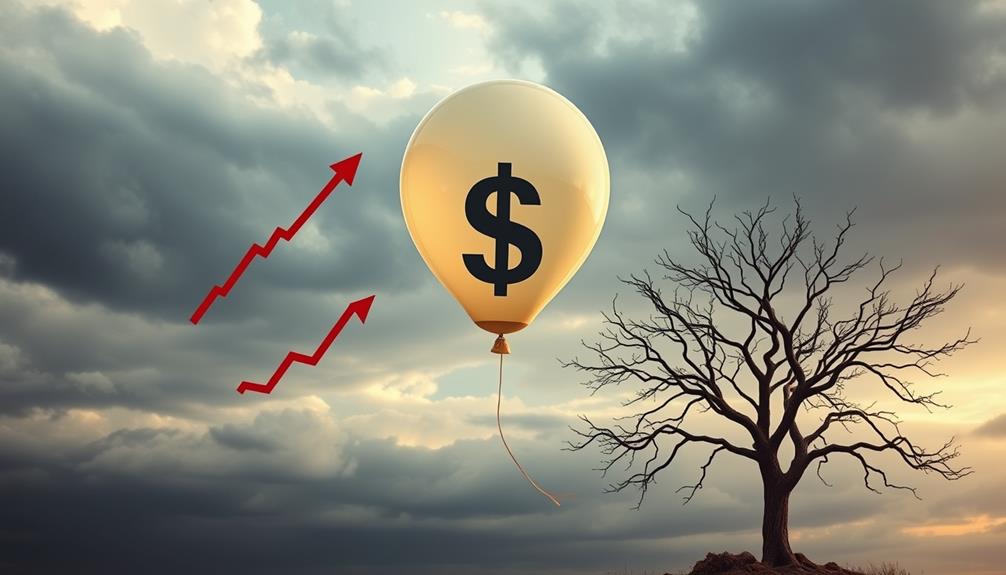The right size for your emergency fund depends on your personal expenses, health, income stability, and risk comfort, but most retirees aim for 3 to 6 months of living costs. To find your ideal amount, list essential expenses and consider how long you’d need to cover unexpected costs. Regularly reviewing and adjusting your savings helps guarantee you’re prepared. Keep exploring to learn more about how to effectively determine and maintain your safety net.
Key Takeaways
- Aim for 3 to 6 months of essential living expenses, adjusted for personal health, stability, and market conditions.
- Consider factors like healthcare costs, income stability, and inflation when determining your emergency fund size.
- Regularly review and update your reserve to reflect changing expenses and financial circumstances.
- Automate savings and use high-yield accounts to build your emergency fund efficiently.
- Tailor your emergency fund to your comfort level and risk tolerance for optimal financial security.
Why Every Retiree Needs an Emergency Fund

Having an emergency fund is vital for retirees because unexpected expenses can arise at any time, and without a financial cushion, these costs can quickly disrupt your retirement plans. An emergency fund provides peace of mind, allowing you to handle sudden medical bills, home repairs, or other urgent needs without dipping into your investments or savings intended for long-term growth. It also supports sound estate planning by protecting your assets from being drained during emergencies. Plus, maintaining liquidity guarantees you can diversify your investments strategically, reducing risk and safeguarding your retirement income. Without a dedicated fund, you risk financial instability, which can compromise your independence and future security. Building and maintaining an emergency fund is an essential step in securing a stable, worry-free retirement.
Determining the Ideal Amount for Your Emergency Fund

Calculating the right size for your emergency fund is essential to make sure you’re prepared for unexpected expenses without tying up too much of your savings. Typically, retirees aim for three to six months’ worth of living costs, but your ideal amount depends on your unique circumstances. Consider your investment strategies—liquid assets like savings accounts or money market funds provide quick access when needed. Also, be mindful of tax implications; withdrawing funds from certain accounts may trigger taxes or penalties, affecting your available cash. Your goal is to balance safety and flexibility, ensuring enough liquidity without compromising your investment growth. Regularly review your emergency fund to account for changes in expenses, health needs, or market conditions, so it remains aligned with your retirement lifestyle.
Factors Influencing the Size of Your Reserve

The size of your emergency fund should reflect your personal situation and risk factors. Your investment strategies, income stability, and health considerations influence how much you need. Additionally, inflation impact can erode your purchasing power, requiring a larger reserve. To better understand, consider this table:
| Factor | Effect |
|---|---|
| Investment strategies | Conservative strategies may require a larger fund for safety. |
| Income stability | Unsteady income increases emergency fund needs. |
| Healthcare costs | Higher medical expenses demand more reserves. |
| Inflation impact | Rising costs mean your fund must grow over time. |
How to Calculate Your Personal Safety Net

To determine your personal safety net, start by evaluating your monthly expenses so you know exactly what you need to cover. Next, decide how many months you want your emergency fund to support you during unforeseen events. This will give you a clear target for building a safety net that truly protects your retirement finances.
Assess Monthly Expenses
How can you determine the amount of money you need each month to cover your essential expenses? Start by listing fixed costs like housing, utilities, and insurance. Next, estimate variable expenses such as groceries, healthcare, and transportation. Be mindful of potential tax implications that could affect your net income. To help prioritize, consider this breakdown:
| Essential Expenses | Estimated Monthly Cost |
|---|---|
| Housing & Utilities | $1,500 |
| Food & Healthcare | $600 |
| Transportation | $300 |
| Miscellaneous | $200 |
Total essential expenses give you a clear picture of your minimum monthly needs. Remember, your safety net should also account for future investment strategies and unexpected costs. Accurate assessment guarantees your emergency fund suffices during unforeseen circumstances.
Determine Emergency Duration
Once you’ve identified your monthly expenses, the next step is figuring out how long your emergency fund needs to last. Consider potential unexpected expenses that could arise, like medical emergencies or home repairs. Estimating your emergency duration helps you build a realistic safety net. Think about these factors:
- Your health and age, which influence how long you might need support
- The stability of your income sources during emergencies
- How quickly you can access additional funds if needed
- The likelihood of short-term versus long-term crises
- Your comfort level with different emergency durations
Strategies for Building and Growing Your Emergency Fund

To build and grow your emergency fund effectively, you should prioritize saving until you reach your goal. Automating your contributions makes it easier to stay consistent and grow your savings over time. Regularly reviewing and adjusting your plan guarantees your fund keeps pace with your changing needs.
Prioritize Emergency Savings
Building and growing your emergency fund should be a top priority to guarantee financial security in retirement. A solid emergency fund provides peace of mind and flexibility during unexpected events. To maximize your savings, consider strategies like investment diversification to spread risk and optimize growth. Take advantage of tax advantages available through certain accounts to make your savings work harder for you. Focus on these key actions:
- Set clear savings targets based on your expenses
- Use high-yield savings accounts for better interest rates
- Regularly review and adjust your savings plan
- Leverage tax-advantaged accounts for added benefits
- Diversify investments to reduce risk and enhance growth potential
Prioritizing these steps ensures your emergency fund remains resilient, supporting your retirement stability.
Automate Contributions Regularly
Automating your contributions makes it easier to consistently grow your emergency fund without the need for constant manual effort. Setting up automatic transfers ensures money moves regularly from your checking account to your savings account, keeping your savings automation seamless. This approach eliminates the temptation to skip deposits or delay saving, helping you stay on track toward your goal. By automating contributions, you remove emotional barriers and reduce the risk of forgetting or procrastinating. You can schedule transfers monthly or with each paycheck, making saving habitual and effortless. Over time, these small, consistent contributions add up, building a solid financial cushion that provides peace of mind during unexpected events. Automate your savings, and watch your emergency fund grow steadily without constant oversight.
Maintaining and Adjusting Your Emergency Savings Over Time

As your financial situation and expenses evolve in retirement, it’s vital to regularly review and adjust your emergency savings. Life changes, market fluctuations, and unexpected costs demand flexibility. To stay prepared, consider these key points:
- Reassess your savings goal regularly based on current expenses.
- Maintain investment diversification to safeguard your funds.
- Integrate your emergency fund into your estate planning for seamless management.
- Adjust your contributions if your income or expenses change.
- Keep a buffer for inflation to make certain your savings stay adequate over time.
Common Mistakes to Avoid When Managing Retirement Funds

Managing your retirement funds requires careful attention, because overlooking common pitfalls can jeopardize your financial security. One major mistake is falling into investment pitfalls, such as taking on high-risk assets without proper diversification or understanding the market. These errors can lead to significant losses, especially during volatile periods. Additionally, ignoring tax implications can erode your savings. Failing to plan for taxes on withdrawals or neglecting tax-efficient investment strategies may reduce your nest egg faster than expected. Another mistake is withdrawing too much too early, leaving insufficient funds for later years. To avoid these pitfalls, stay informed about investment options, consult professionals when needed, and develop a tax-smart withdrawal plan. Being proactive helps safeguard your retirement funds and ensures lasting financial stability.
Frequently Asked Questions
How Often Should I Review and Update My Emergency Fund?
You should review and update your emergency fund at least once a year, or whenever your financial situation changes considerably. Regular reviews help you adapt your investment strategies and guarantee risk management remains effective. Life events like retirement, health issues, or market shifts can impact your needs. By staying proactive, you maintain a fund that truly supports you in emergencies, giving you peace of mind and financial security.
Are There Specific Investment Options Suitable for Emergency Savings?
You should prioritize high yield savings accounts for your emergency fund since they offer better interest rates and quick access to cash. Investment accounts aren’t ideal because they can be less liquid and subject to market fluctuations. Keep your emergency savings in a safe, accessible place like a high yield savings account, ensuring you can tap into it immediately when needed without risking investment losses.
What if My Expenses Increase After I’Ve Saved Enough?
If your expenses increase due to inflation impact or unexpected expenses, consider boosting your emergency fund. Review your current savings and add more to cover these new costs. Keep an eye on inflation trends and adjust your savings accordingly. Having a flexible, larger emergency fund guarantees you’re prepared for unforeseen expenses and inflation-driven costs, providing peace of mind and financial security in your retirement years.
Should I Keep My Emergency Fund in Cash or Other Assets?
Your emergency fund is your financial lifeline—don’t risk it with risky assets. Keep most of it in cash for quick access, ensuring high liquidity when emergencies strike. However, consider some diversification by holding a small portion in low-risk investments to potentially grow your fund. Balance liquidity considerations with safety, so your emergency fund remains reliable, no matter what surprises come your way.
How Do Unexpected Healthcare Costs Impact My Emergency Fund Needs?
Unexpected healthcare costs can substantially increase your emergency fund needs, especially if you face medical emergencies without adequate health insurance. You’ll want to set aside more cash to cover out-of-pocket expenses, co-pays, or treatments not fully covered. Having a robust emergency fund ensures you’re prepared for sudden healthcare surprises, giving you peace of mind and financial security during health crises. Prioritize maintaining enough liquidity to handle these unexpected medical costs comfortably.
Conclusion
So, remember, your emergency fund is your retirement safety net—because nothing says “prepared” like having a stash of cash for when life throws a curveball. Don’t skimp now and end up eating ramen in your golden years. Keep building, stay vigilant, and maybe, just maybe, avoid the classic mistake of relying on luck or credit cards. After all, your future self will thank you—if they’re not too busy laughing at your missteps.









